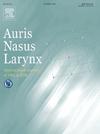利用Thiel尸体进行内窥镜颈部清扫的最佳入路评估
IF 1.5
4区 医学
Q2 OTORHINOLARYNGOLOGY
引用次数: 0
摘要
目的内镜下颈部解剖术(END)在亚洲已经发展起来;然而,有必要验证一种学习曲线短且易于引入的技术。本研究的目的是确定最简单的介绍和最短的学习曲线的方法,使用捐献的尸体用Thiel方法固定。方法对四种不同的方法进行了研究。通过对5名头颈外科医生进行问卷调查来评估每种方法,确定清扫程度,并计算清扫淋巴结的数量。结果经耳后入路从胸锁乳突肌(SCM)前缘入路的内镜下肩胛舌骨上颈清扫术(SOHND)在问卷中评价最高,且本研究清扫的淋巴结数量和清扫程度合理。从锁骨下进入颈动脉前缘的颈静脉清扫术(JND)是评分第二高的入路,但需要进一步的仪器开发和技术进步。结论内镜下采用RA入路治疗SOHND是最佳方法。锁骨下入路的内窥镜JND是第二有希望的入路。本文章由计算机程序翻译,如有差异,请以英文原文为准。
Evaluation of the optimal approach for endoscopic neck dissection using Thiel cadavers
Objective
Endoscopic neck dissection (END) has been developed in Asia; however, it is necessary to validate a technique that has a short learning curve and is easy to introduce. The purpose of this study was to determine the approach with the easiest introduction and shortest learning curve using donated cadavers fixed with the Thiel method.
Methods
A total of four different approaches were examined. Each approach was evaluated by a questionnaire administered to five head and neck surgeons, the extent of dissection was confirmed, and the number of dissected lymph nodes was counted.
Results
Endoscopic supra-omohyoid-neck dissection (SOHND) by entering from the anterior margin of the sternocleidomastoid muscle (SCM) through a retroauricular (RA) approach was the most highly rated in the questionnaire, and the extent of dissection and number of lymph nodes dissected were reasonable in this study. Jugular neck dissection (JND) by entering the anterior margin of the SCM from the subclavian was the second highest scoring approach, but further advances in instrument development and technique are needed.
Conclusions
Endoscopic SOHND by the RA approach was considered optimal. Endoscopic JND by the subclavian approach was the second most promising approach.
求助全文
通过发布文献求助,成功后即可免费获取论文全文。
去求助
来源期刊

Auris Nasus Larynx
医学-耳鼻喉科学
CiteScore
3.40
自引率
5.90%
发文量
169
审稿时长
30 days
期刊介绍:
The international journal Auris Nasus Larynx provides the opportunity for rapid, carefully reviewed publications concerning the fundamental and clinical aspects of otorhinolaryngology and related fields. This includes otology, neurotology, bronchoesophagology, laryngology, rhinology, allergology, head and neck medicine and oncologic surgery, maxillofacial and plastic surgery, audiology, speech science.
Original papers, short communications and original case reports can be submitted. Reviews on recent developments are invited regularly and Letters to the Editor commenting on papers or any aspect of Auris Nasus Larynx are welcomed.
Founded in 1973 and previously published by the Society for Promotion of International Otorhinolaryngology, the journal is now the official English-language journal of the Oto-Rhino-Laryngological Society of Japan, Inc. The aim of its new international Editorial Board is to make Auris Nasus Larynx an international forum for high quality research and clinical sciences.
 求助内容:
求助内容: 应助结果提醒方式:
应助结果提醒方式:


